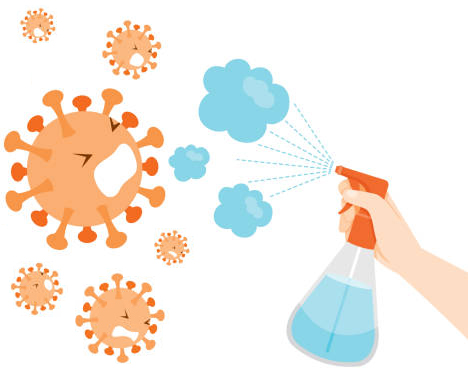Disinfectants & sanitizers keep your family healthy & safe
Disinfectants and sanitizers work to combat the spread of germs in the home and other settings. Disinfectants destroy microorganisms on surfaces, while sanitizers reduce the level of microorganisms present by significant numbers or to acceptable levels established by federal or provincial health authorities.
Opportunities for the transmission of infectious disease in our society are widespread. Although often spread by person-to-person contact, the bacteria and viruses that cause infectious disease can also survive for long periods of time on hard surfaces such as tables, counters, handles, faucets, sinks, telephones, keyboards and toilet areas. These surfaces provide reservoirs from which contamination spreads to susceptible individuals who touch these surfaces and then infect themselves by touching their eyes or nose or through ingestion.
The following are some examples of diseases and infections that are readily spread via environmental surfaces:

Common Cold
- The average adult gets about two to five colds per year, most often during the winter. Infants can get up to eight in a year because their body’s defences aren’t yet developed. Preschool children average five to seven cold episodes each year.
- It is estimated that 40% of time lost from work and 30% of school absences are due to the common cold.
- Symptoms of the common cold include red eyes, a sore throat, sneezing and a runny nose.
- Close contact with infected individuals enables the cold to spread to other individuals through the nose or eyes.
- Handwashing with soap and water and cleaning frequently touched surfaces with disinfectants are effective strategies to prevent the common cold.
- When using a disinfectant or sanitizer, consult the product’s label “Directions For Use” section to understand how much of the product to use and which surfaces they are suitable for.
- Labels also have helpful information on the pathogens that the sanitizer/disinfectant is effective against (for example, rhinoviruses).
From the Canadian Centre for Occupational Health and Safety, the American Cleaning Institute, and the Wellington-Dufferin-Guelph Public Health Unit
Common Infections in Daycare Settings
- Rotavirus, which is the cause of a large percentage of debilitating diarrheal infections, spread in and through day care centres, can remain viable on non-porous surfaces (toys, telephones, play tables, etc.) for up to 10 days. 95% of children contract rotavirus by 5 years of age and it is associated with 7,500 hospitalizations in Canada annually.
- Common respiratory illnesses found in daycare settings like Respiratory Syncytial Virus (RSV) causes infection of the lungs and respiratory tract which can cause severe infection in young children. In Canada approximately 2% of all infants are hospitalized with RSV in their first year of life.
- Children are known to put hands and objects in their mouths every 2-3 minutes, enhancing spread of these viruses once they reach toys or commonly touched surfaces like doorknobs, counters, and tables.
- Cleaning hands with soap and water as well has having hand sanitizer available for teachers, staff and children is effective in limiting the spread of common infections found in daycare settings. To understand how to use sanitizers/disinfectants and the diseases they kill, consult the direction for use and the list of pathogens the product is effective against on the product label.
From the Mayo Clinic, Health Canada, the National Advisory Committee on Immunization (NACI), the government of British Columbia the Journal of Clinical Microbiology, the Journal of Hygiene (online at the Pubmed Database of the National Center for Biotechnology Information, National Library of Medicine, National Institutes of Health), the American Cleaning Institute, and the Wellington-Dufferin-Guelph Public Health Unit
Food-borne Diseases
- Food is often contaminated by contact with contaminated utensils, countertops and other kitchen surfaces or through improper handling.
- Clostridium perfingrens which account for 170 thousand cases yearly in Canada is found in settings like hospitals, cafeterias, and schools because large amount of food may be prepared in advance and kept warm until mealtime thus allowing bacteria to multiply.
- Even relatively low levels of contamination on kitchen surfaces and food can present a hazard.
- Norovirus, the most common foodborne illness in Canada accounts for over 1 million known infections and 1 thousand hospitalizations per year. Symptoms of norovirus like nausea, diarrhea, stomach pain, and vomiting may start as soon as 12 hours after exposure.
- Salmonella, which contributes to 1 in 4 hospitalizations of all food-borne illnesses, is an organism that survives on non-porous kitchen surfaces for up to 24 hours and on clean cloths for up to 48 hours.
- Listeria, the leading cause of deaths related to food-borne illnesses each year can be found in contaminated food or drink and can lead to symptoms including fever, nausea, diarrhea, and headaches.
- Washing hands with warm water and soap as well as cleaning surfaces, cutting boards, and utensils with surface sanitizers are effective prevention strategies against food-borne diseases. It is important to understand how to use disinfectants/sanitizers, therefore you should consult the product’s “Direction For Use” section on its label as well as pathogens the disinfectant/sanitizer can kill.
From Health Canada, the Centers for Disease Control and Prevention (CDC), The Lancet (online at the Pubmed Database of the National Center for Biotechnology Information, National Library of Medicine, National Institutes of Health), the Journal of Environmental Health, the American Cleaning Institute, and the Wellington-Dufferin-Guelph Public Health Unit
Healthcare Associated Infections
Hepatitis A
- The hepatitis A virus causes liver inflammation where 25% of adult cases of Hepatitis A require hospitalization in Canada
- Common symptoms like tiredness, nausea, dark urine, and loss of appetite develop infrequently in children, which enables the spread of hepatitis A into the general public
- Clinical studies show the hepatitis A virus survives on inanimate surfaces and human hands and can be transmitted from surfaces to humans via this route.
- Good hygiene through handwashing and cleaning commonly touched surfaces with sanitizers are effective methods to protect yourself from hepatitis A
From the Government of Canada, Health Canada, the Mayo Clinic, New England Journal of Medicine, the Journal of Clinical Microbiology and the Journal of Clinical Microbiology (online at the Publiced Database of the National Center for Biotechnology Information, National Library of Medicine, National Institutes of Health), the American Cleaning Institute, and the Wellington-Dufferin-Guelph Public Health Unit
C difficile
- Clostridioides difficle (C difficile) is a bacteria that causes infections, particularly in hospitals and long-term care settings.
- Individuals get infected by C difficile through touching surfaces contaminated with feces then touching their mouths.
- Symptoms of C difficile include watery diarrhea, fever, loss of appetite, and nausea.
- In 2022, there were 1.41 infections per 1 000 patient admissions in Canadian hospitals.
- Washing your hands with soap and water as well as disinfecting surfaces and laundry with hot water or bleach are effective methods of preventing C difficile.
- Consulting the label’s directions for use and list of pathogens the sanitizer/disinfectant can kill is an effective measure to protect yourself from C difficile.
From the Public Health Agency of Canada, the Canadian Antimicrobial Resistance Surveillance System (CARSS), and the Centers for Disease Control and Prevention, the American Cleaning Institute and, the Wellington-Dufferin-Guelph Public Health Unit
Coronaviruses
- Coronaviruses are a large family of viruses that are associated with mild illnesses, similar to that of the common cold.
- SARS-CoV-2, the virus that causes COVID-19, spreads when an infected person releases infectious respiratory particles into the air when they breathe, talk, cough, or sneeze.
- Individuals can be infected if they breathe in infectious particles or touch their eyes, nose, or mouth after touching a contaminated surface.
- Vaccination, personal protective equipment, hand washing, and sanitizing high-touch surfaces and objects are effective methods to protect yourself from COVID-19.
- It is important to understand how to use disinfectants/sanitizers, therefore you should consult the product’s “Direction for Use” section on its label as well as pathogens the product can kill.
From the Government of Canada, Health Canada and the Canadian Centre for Occupational Health and Safety, the American Cleaning Institute, and the Wellington-Dufferin-Guelph Public Health Unit
How Surface Disinfectants and Sanitizers (Biocides) are Regulated in Canada
What Are Biocides?
Biocides are products that sanitize or disinfect hard or soft non-living and non-liquid surfaces to prevent disease in humans or animals. These products are used on surfaces to help kill or reduce harmful microorganisms and are vital in preventing the spread of germs and bacteria at home, in schools, and in public spaces. The term “biocides” is a new Health Canada term to capture products such as surface disinfectants and sanitizers and food contact sanitizers (used in food processing/establishments and food prep areas restaurants).
To be sold in Canada, biocides must be reviewed and authorized by Health Canada to ensure they are safe, effective, and properly labeled. To be considered a biocide under Canadian regulations, a product must meet efficacy requirements and kill or reduce at least 99.9% of targeted microorganisms (a 3-log reduction).
Biocide ingredients are subject to review under the Canadian Environmental Protection Act (CEPA), which governs the assessment and management of substances for environmental and human health risks.
How to Tell If a Product Is Authorized
Look for an 8-digit Drug Identification Number (DIN) on the label (e.g., DIN 01234567). The DIN shows the product has been reviewed and approved for use as a biocide in Canada.
New Biocides Regulations
Until May 31, 2025, surface disinfectants and disinfectant-sanitizers were regulated as drugs under the Food and Drugs Regulations (FDR) and assigned a Drug Identification Number (DIN), while surface sanitizers were generally regulated as pest control products under the Pest Control Products Act (PCPA). Surface sanitizers for use in food premises were regulated under the Food and Drug Act, and subject to voluntary review under Health Canada’s Bureau of Chemical Safety.
Canada has introduced new Biocides Regulations, which came into effect on May 31, 2025. These regulations bring surface disinfectants and surface sanitizers under one consistent framework to make sure all products meet modern standards for safety and effectiveness. Under the new rules, products with a biocide will need a DIN and must go through a pre-market review with Health Canada to be sold.
Transition Period (2025-2031)
There is a 4-year transition period, from May 31, 2025, to May 31, 2029, to give manufacturers and importers of surface disinfectants and sanitizers time to move their products to the new framework. By May 31, 2029, all surface disinfectants and surface sanitizers must be authorized under the new Biocides Regulations. Products used to sanitize food contact surfaces in restaurants, commercial kitchens, and food processing facilities/establishments have until May 31, 2031, to meet the new requirements.
During this transition time, products may still be sold under the previous system, either as disinfectants (under the FDR), as pest control products (under the PCPA), or as food contact sanitizers under the FDA. During this period, you may see DINs and PCP numbers on surface disinfectants and sanitizers while companies make the switch, while food contact sanitizers may have no unique identifier (as this was not a requirement under the previous framework).
Why This Matters to You
The Biocides Regulations ensure authorized products have gone through a rigorous review process to make sure they work as intended and are safe to use. Health Canada continues to monitor products after they’re approved to ensure they remain safe and effective. Always follow the directions on the label before using a disinfectant or sanitizer.
For More Information
Visit canada.ca/biocides for more on how biocides are reviewed and approved.
